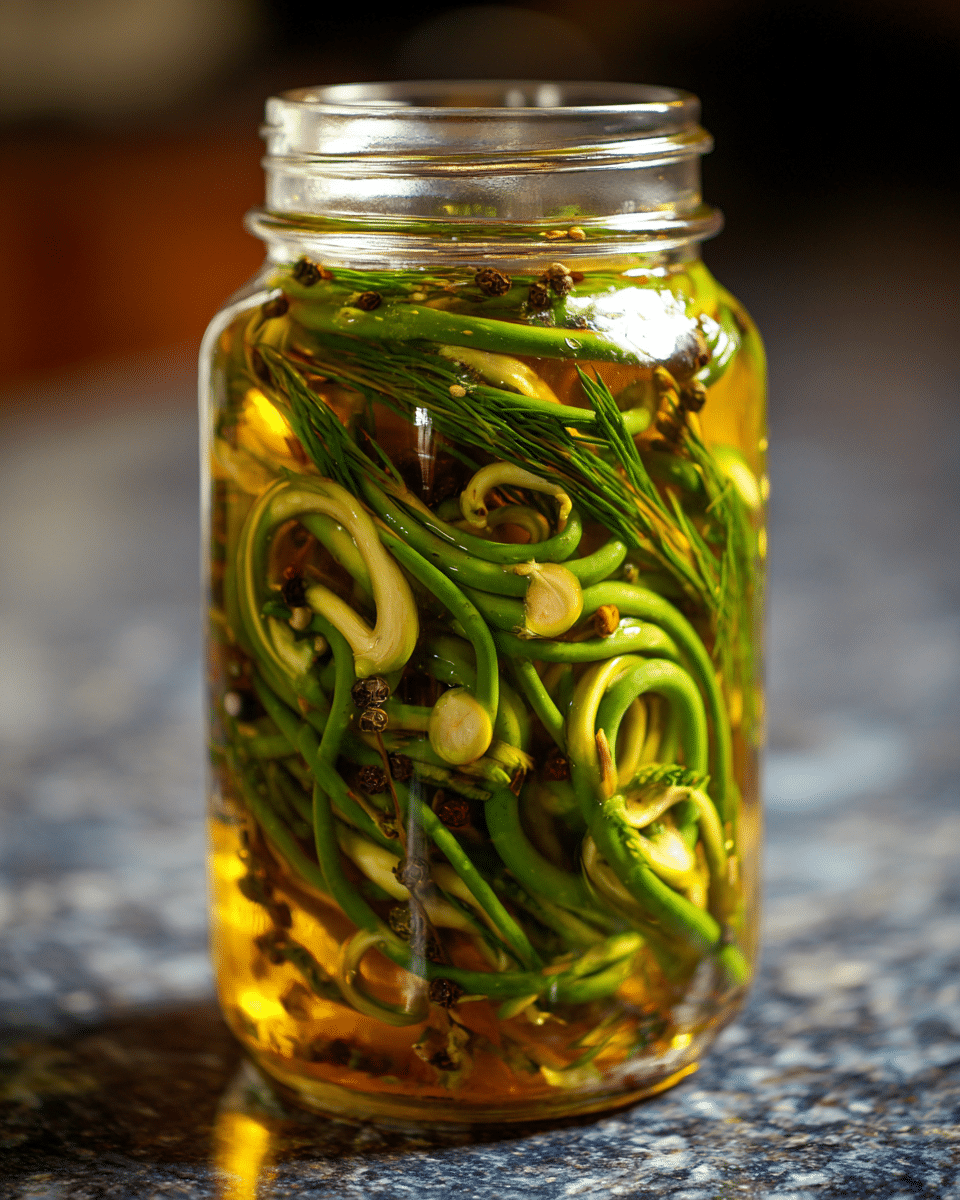Pickled garlic scapes are a unique and flavorful way to preserve the curly green shoots of garlic plants. Known for their mild garlicky flavor and satisfying crunch, garlic scapes make an excellent pickled snack, condiment, or garnish. This recipe highlights their natural bite with a tangy brine infused with spices, creating a delicious addition to cheese boards, sandwiches, salads, or Bloody Marys. It’s a simple, seasonal way to enjoy garlic in an entirely new form.
FULL RECIPE
Ingredients
- 1 pound fresh garlic scapes, trimmed and cut into 4- to 5-inch pieces
- 1 cup white vinegar
- 1 cup water
- 1 tablespoon pickling salt (or kosher salt)
- 1 tablespoon sugar
- 1 teaspoon mustard seeds
- 1 teaspoon whole black peppercorns
- ½ teaspoon crushed red pepper flakes (optional)
- 2 dill sprigs or 1 teaspoon dried dill (optional)
- 2 cloves garlic, peeled
Directions
- Sterilize two pint-sized canning jars and their lids by boiling them for 10 minutes or running them through a dishwasher cycle. Let them dry.
- Wash the garlic scapes and trim off any flower buds. Cut the scapes into pieces that will fit in your jars, about 4 to 5 inches in length.
- Divide the mustard seeds, black peppercorns, crushed red pepper flakes, dill (if using), and garlic cloves between the two jars.
- Pack the garlic scapes vertically into the jars, arranging them tightly but without crushing them.
- In a small saucepan, combine the white vinegar, water, salt, and sugar. Bring the mixture to a boil, stirring to dissolve the salt and sugar.
- Carefully pour the hot brine over the garlic scapes in each jar, leaving about ½ inch of headspace at the top.
- Tap the jars gently to release any trapped air bubbles, then seal tightly with the sterilized lids.
- Let the jars cool to room temperature, then refrigerate for at least 1 week to allow the flavors to develop.
- Pickled garlic scapes will keep in the refrigerator for up to 3 months.
Nutrition Facts
- Calories: 10
- Total Fat: 0g
- Saturated Fat: 0g
- Trans Fat: 0g
- Cholesterol: 0mg
- Sodium: 220mg
- Total Carbohydrates: 2g
- Dietary Fiber: 0g
- Sugars: 1g
- Protein: 0g
- Vitamin A: 0% DV
- Vitamin C: 4% DV
- Calcium: 1% DV
- Iron: 1% DV
The Unique Flavor Profile of Pickled Garlic Scapes
Pickled garlic scapes offer a distinctive taste that balances the mild, fresh garlicky flavor of the scapes with the sharp tanginess of the vinegar brine. The pickling process softens the raw bite of garlic scapes while enhancing their natural crunch, making them an exciting alternative to traditional pickled vegetables. The subtle spice from mustard seeds and peppercorns adds complexity, and optional additions like dill or crushed red pepper flakes can give extra aromatic and spicy notes.
Health Benefits of Garlic Scapes
Garlic scapes, like their garlic bulb counterparts, contain compounds known for their antioxidant and anti-inflammatory properties. They provide small amounts of vitamins C and B6, manganese, and selenium. Pickling preserves these nutrients while adding probiotics when fermented naturally, which can support gut health. Additionally, garlic compounds are linked to cardiovascular benefits, including blood pressure regulation and cholesterol reduction, making pickled scapes not only tasty but potentially heart-friendly.
Choosing and Preparing Garlic Scapes for Pickling
When selecting garlic scapes, look for firm, bright green stalks without blemishes or wilted ends. Freshness is key to achieving the best crunch and flavor in pickling. Trimming the ends and cutting the scapes into manageable pieces helps ensure even pickling and easy jar packing. Removing the flower buds (which can be tough or bitter) improves texture and taste. Proper washing removes dirt and any residual pesticides, preparing the scapes perfectly for the brine.
The Science Behind Pickling and Preservation
Pickling uses an acidic brine, typically vinegar-based, to preserve vegetables by creating an environment hostile to bacteria growth. The salt in the brine helps draw moisture out and inhibit spoilage organisms, while the heat from boiling the brine ensures all ingredients are sterilized before sealing. This method extends shelf life significantly, allowing garlic scapes to be enjoyed well beyond their short growing season. The process also develops deepened flavors over time as the scapes soak up the spices and vinegar.
Variations and Flavor Enhancements
One of the joys of pickling garlic scapes is the ability to customize the brine and spices. For a sweeter version, honey or maple syrup can replace sugar. Adding whole coriander seeds, bay leaves, or fresh herbs like thyme and rosemary can create unique flavor profiles. For a spicier kick, more crushed red pepper flakes or fresh chili slices can be introduced. Experimenting with different types of vinegar—apple cider, rice vinegar, or red wine vinegar—can also subtly alter the taste, tailoring the pickles to different culinary uses.
Serving Suggestions and Pairings
Pickled garlic scapes are versatile and can be enjoyed straight from the jar as a snack or appetizer. They complement cheese boards beautifully, pairing well with sharp cheddars, creamy bries, or tangy goat cheese. Their tangy crunch adds freshness to sandwiches, burgers, and wraps, and they can be chopped and tossed into salads for a burst of flavor. For cocktails, they make an intriguing garnish for Bloody Marys or savory martinis, adding an unexpected garlicky twist.
Storage Tips for Longevity and Quality
Once pickled, garlic scapes should be stored in the refrigerator to maintain optimal freshness and safety. The acidic environment slows bacterial growth, but refrigeration prevents spoilage and preserves texture. Using sterilized jars and lids helps avoid contamination and extends shelf life. If sealed properly, pickled garlic scapes can last up to three months. Always use clean utensils to remove them from the jar to avoid introducing bacteria.
Potential Culinary Uses Beyond Pickling
Beyond eating them as pickles, garlic scapes can be incorporated into various dishes. After pickling, they can be finely chopped and stirred into salad dressings or vinaigrettes for added zing. They can be blended into dips or sauces for a mild garlic flavor without overpowering heat. Pickled scapes can also be chopped and sprinkled over roasted vegetables or grilled meats, providing acidity and crunch that balances richer flavors.
Pairing Pickled Garlic Scapes with Seasonal Ingredients
Pickled garlic scapes work wonderfully with other spring and summer produce. They pair well with fresh tomatoes, cucumbers, and radishes in salads, creating bright, refreshing dishes. The acidity complements the sweetness of roasted carrots or beets. They can also enhance grain bowls or cold pasta salads featuring fresh herbs, chickpeas, or grilled corn. This seasonal harmony highlights the fresh, crisp textures and vibrant flavors of early harvests.
Cultural and Traditional Context of Garlic Scape Pickling
Pickling garlic scapes is a practice rooted in traditional food preservation methods across many cultures, particularly in regions where garlic is widely grown. This technique not only extends the usability of garlic scapes, which have a limited fresh availability, but also adds culinary diversity. In some Asian and Eastern European cuisines, pickled garlic and its shoots are prized for their pungent flavor and health benefits, showcasing the global appreciation for this often-overlooked vegetable.
Conclusion
Pickled garlic scapes are a delightful way to enjoy the fresh, mild garlicky flavor of scapes with a satisfying tangy crunch. Their versatility, health benefits, and long shelf life make them an excellent pantry staple during garlic scape season and beyond. Whether enjoyed as a snack, an ingredient in recipes, or a flavorful garnish, pickled garlic scapes offer a unique culinary experience that brings bright, bold flavor to a variety of dishes. With endless customization options and simple preservation techniques, they invite both novice and experienced home cooks to explore and celebrate this seasonal treasure.






